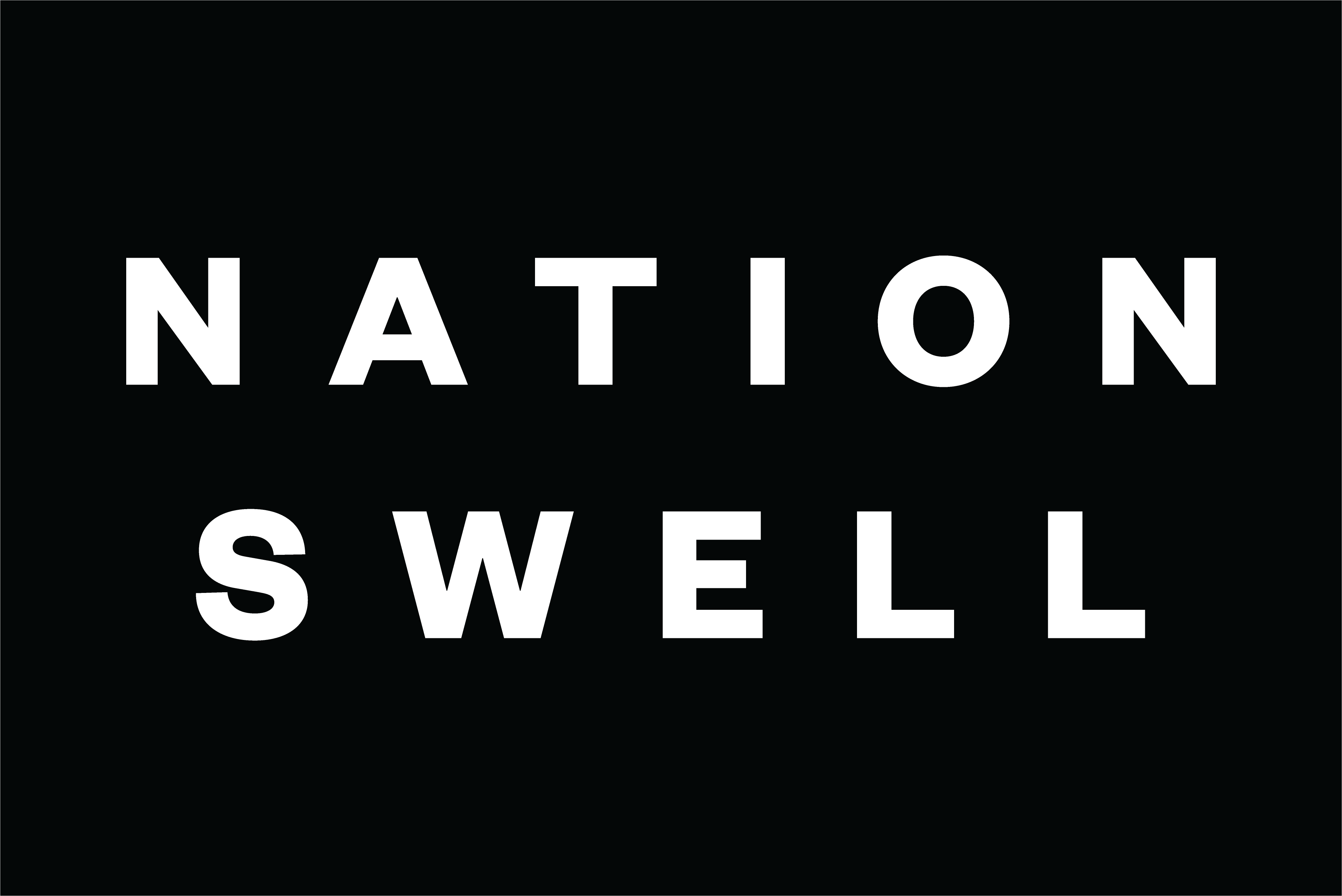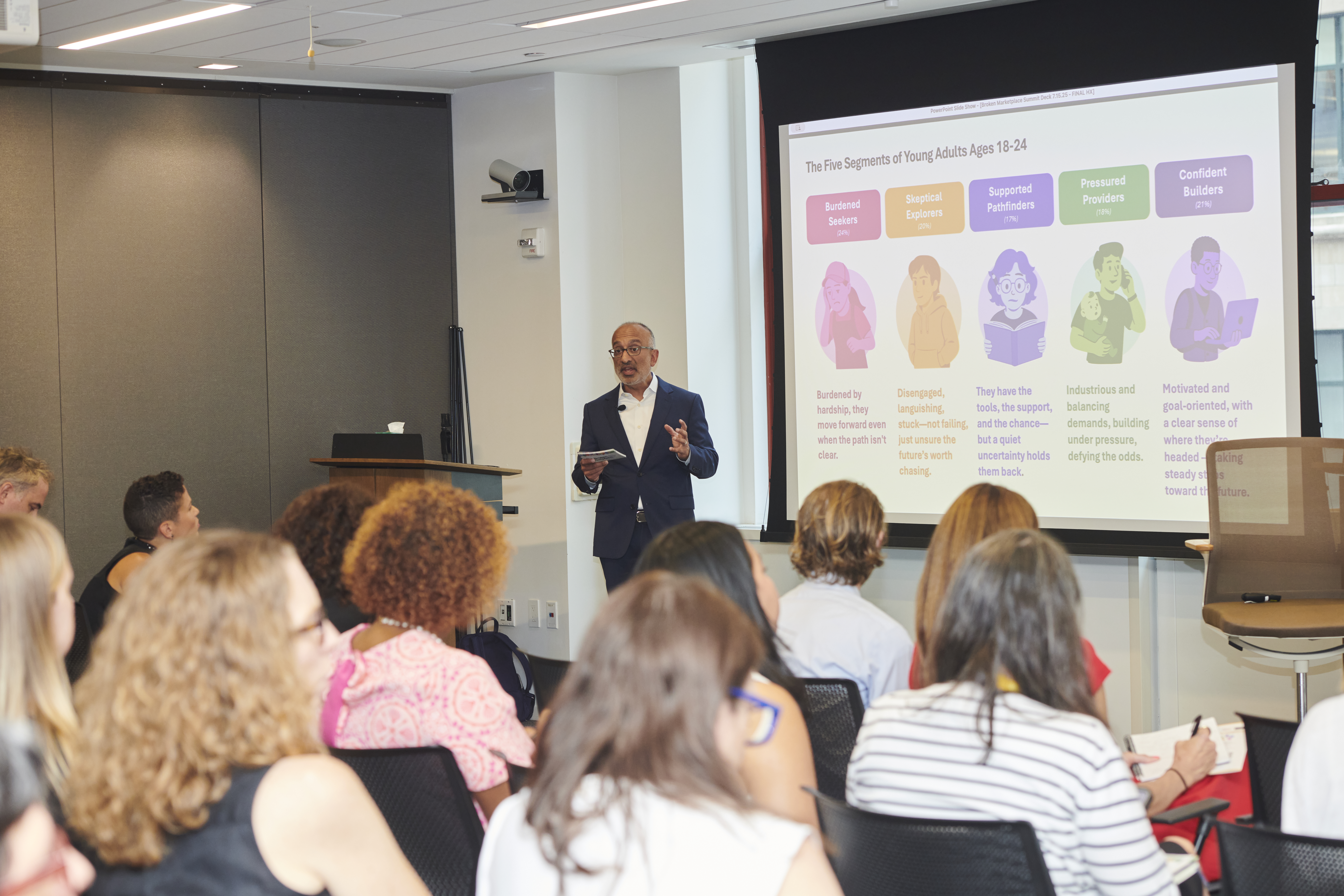Across the country, too many young people are doing everything right — working jobs, enrolling in training, and seeking advice — only to find themselves stuck. Despite their effort and ambition, the pathway to a stable, fulfilling adulthood has grown increasingly murky. New research from the Schultz Family Foundation and HarrisX puts a name to this disconnect: a broken marketplace. In this labor and education ecosystem, jobs go unfilled while talent goes underrecognized, and the traditional systems of guidance — school counselors, college degrees, even parental advice — no longer align with what the market demands. It’s a system that leaves too many behind — particularly young people from under-resourced communities, who are often navigating without a map.
To surface solutions and spark collaboration, SFF teamed up with NationSwell and LinkedIn on July 15 to convene some of the leading thinkers, practitioners, and changemakers exploring what it will take to fix this broken marketplace. The conversation spanned everything from the promise and pitfalls of AI, to the cultural overvaluation of four-year degrees, to the structural barriers facing youth who are working hard but treading water. While the dialogue surfaced powerful models and bright spots, it also revealed a shared hunger for something deeper: a reimagined system that meets young people where they are, honors their full potential, and builds pathways that are truly navigable, equitable, and aligned with the future of work.
Below are some of the most salient insights that surfaced during the discussion — and a few questions we’re still asking.
Fast Stats:
- 30 million young people in the U.S. are struggling, with roughly 15 million classified as underemployed or unemployed.
- Only 8% of high schoolers feel confident about their post-graduation plans.
- 86% of high school leaders say they recognize the importance of postsecondary planning — yet workforce readiness is still not meaningfully integrated into most school systems.
- While 71% of employers say there are enough opportunities for job seekers, only 43% of young adults agree
- Only 24% of parents claim to leverage school resources like guidance counselors and teachers.
- 73% of parents see their child as having direction or purpose on their own and not needing help.
- Only 35% of young adults report knowing exactly what drives them
- More than half of young adults say they do not believe that college offers the guarantee of a good job.
Insights:
- The labor market is experiencing a skills and credential mismatch. There’s a growing imbalance between the number of college-educated workers and the actual demand for degree-dependent roles. Simultaneously, there are increasing opportunities for non-degree workers — especially those with the right technical or vocational skills — which signals the need to reassess postsecondary education strategies.
- Millions of young people — especially women — currently feel unprepared to enter the current U.S. job market. Despite performing well academically in adolescence, a growing number of young women report feeling unready for the workforce as they approach adulthood. This decline in self-confidence appears to stem from a mix of systemic and social pressures: cultural expectations around caregiving, implicit biases in hiring, and a lack of tailored support for young mothers or women from low-income households.
- AI offers both promise and risk; it’s up to us to shape the outcomes. While artificial intelligence has the potential to revolutionize education, guidance, and workforce development, its impacts will depend entirely on how we design and deploy it. Leaders must proactively steer AI toward equitable and beneficial uses instead of passively responding to its disruptions.
- The jobs of the future will demand radically different skills. By 2030, 70% of the skills required for many jobs are projected to shift. This rapid evolution places tremendous pressure on workers, educators, and employers to anticipate change, reskill continuously, and adapt to a moving target.
- We must not leave vulnerable communities behind in the AI era. Historically marginalized populations — especially those without college degrees — face the greatest risk of being left out of the AI-driven economy. It’s critical to design tools, supports, and systems that center their needs from the start.
- There is a growing mismatch between college degrees and job outcomes. Despite a rise in college attainment, many recent graduates are struggling to find roles that match their education level, particularly as AI begins to automate white-collar tasks. This disconnect suggests a deeper misalignment in how we prepare people for the labor market.
- A surge in bachelor’s degrees hasn’t been matched by a surge in opportunity. The number of people earning college degrees has increased substantially, yet this hasn’t translated into better job placement or upward mobility for many graduates, hinting at a broken promise in the education-to-employment pipeline.
- People without degrees are outperforming expectations. Contrary to common narratives, employment rates among non-college-educated workers have improved in recent years. This trend challenges assumptions about where economic opportunity lies and signals a need to rethink credentialism.
- Career navigation must be reimagined for the AI era. Many young people are navigating a job market that no longer matches traditional pathways. They need updated guidance systems that reflect today’s labor market realities and help them develop adaptable, durable skills.
- Parents are desperate for modern tools and resources. Many parents feel unprepared to help their children thrive in today’s complex world. They are seeking updated, accessible resources that reflect current realities and equip them to support their kids in meaningful, future-ready ways.
- A place-based, community-driven parenting curriculum could be transformative. There’s an opportunity to create parenting supports that are deeply rooted in local needs, shaped by cross-sector collaboration, and tailored to the real conditions families face on the ground.
- Young people need proximity to possibility. Exposure to mentorship, networks, and real examples of success is critical. Youth are better able to envision and pursue meaningful futures when they can see what’s possible through trusted relationships and intergenerational support.
- Today’s guidance systems are woefully outdated. School counselors and other advisors are often overwhelmed, under-resourced, or operating from outdated assumptions. Young people need future-facing guidance tools that reflect the fast-changing world of work.
- AI could play a role in personalizing and scaling guidance. With the right design and data, AI has the potential to provide tailored, real-time guidance that meets each learner where they are — offering suggestions, pathways, and encouragement in a scalable way.
- The current job market is brutal for Gen Z. Some young people are submitting hundreds of AI-generated cover letters with little success, reflecting both the hyper-competitive nature of today’s labor market and a growing sense of disillusionment about career readiness. Simultaneously, AI-laden recruiting software imposes strict parameters on even the most qualified of candidates, filtering them out of the hiring pipeline unnecessarily.
- Employers are caught in a Catch-22 of their own making: they demand experience yet offer few pathways to get it. Many employers list “prior experience” as a prerequisite for entry-level roles, even as they shrink internship programs, reduce on-the-job training, and fail to create clear earn-and-learn pathways. This paradox disproportionately affects young people — especially those without access to well-networked mentors or unpaid work experience—who find themselves locked out of opportunity before they’ve even begun. The result is a self-perpetuating loop: a talent pool deemed “unprepared” not because of lack of potential, but because the system never gave them a chance to prove it.
- We need more bilingual talent fluent in both tech and impact. There’s a critical shortage of people who understand both advanced AI systems and the complex realities of the social sector. Building cross-functional, technically capable teams will be essential to making AI work for good.
- The most effective nonprofits will couple tech with deep human expertise. Organizations that integrate AI into their strategy while staying grounded in pedagogy, community trust, and lived experience will be best positioned to deliver meaningful outcomes.
- We need faster feedback loops between experience and evidence. Too often, it takes years to understand whether a policy or program has worked. Investing in data infrastructure and short-term proxies for long-term outcomes will help systems learn and improve more quickly.
- A better future requires both urgency and imagination. It’s not enough to simply react to AI; leaders must act urgently to reshape the system — and also imagine radically different, more inclusive possibilities. Otherwise, we risk reinforcing the same inequities under new technological wrappers.
Questions we’re still asking:
1. How can we build career navigation systems that truly reflect today’s labor market realities?
There’s a clear consensus that existing guidance systems (from high school counselors to college pathways) are outdated and disconnected from the fast-moving job market. But what would a truly modernized system look like? How can it be both data-informed and deeply human, scalable and personalized, responsive to local labor conditions but aligned with broader trends like AI disruption?
2. What’s the right role for AI in supporting young people’s transitions into adulthood?
AI came up repeatedly as both a tool of promise and a source of unease. How do we ensure it amplifies human insight rather than replacing it? Can it truly offer equitable guidance without deep community input in its design? And how do we build trust in AI tools among young people who already feel the system is stacked against them?
3. How do we rebalance the perceived value of college versus non-college pathways?
The traditional “college or bust” mindset is breaking down, but what comes next is still murky. What should replace the old hierarchy of credentials? How do we create a labor market and cultural narrative that values skilled trades, apprenticeships, and alternative pathways just as much as a bachelor’s degree?
4. What does it look like to design truly place-based solutions in a national context?
Participants voiced strong belief in localized, community-rooted solutions. But questions remain: How do we balance the nuance of place with the efficiency of national models? Can we scale what’s working locally without flattening what makes it powerful? And what infrastructure is needed to make place-based innovation replicable and sustainable?
5. How do we support young people who are “doing everything right” but still stuck?
A deeply felt tension emerged around the young people who are working hard, following guidance, and still not progressing. Why aren’t their efforts yielding returns? Is it a failure of systems, expectations, or opportunity design? What does justice look like for this group — and what kinds of interventions (navigational, relational, structural) will actually help them move forward?
6. How do we square the inherent tension between the power of industry and the power of the American education system?
Calling on employers and educators to rectify a broken system exposes an uncomfortable truth — businesses have the capital; educators do not. While both employers and the education system will need to make changes in order to better serve young job seekers, the pace of change is unlikely to be equal.
NationSwell’s Workforce Innovation Collaborative:
As SFF’s research reveals, the workforce landscape is shifting rapidly — shaped by AI, automation, shifting demographics, and economic uncertainty. The labor market in the next decade will face urgent challenges and opportunities across every sector and industry. Impact leaders need a trusted space to align on what’s next.
Launching in Fall 2025, NationSwell’s Workforce Innovation Collaborative is where cross-sector leaders come together to explore trends, surface bold practices, and co-design scalable solutions. Collaborative members join a peer-driven learning and action journey — building cross-sector relationships, surfacing bold solutions, and advancing shared impact through strategy, storytelling, and collective action.
Join the collaborative to access curated research, insights, and expert-led workshops that will help you to stay ahead of workforce trends and technologies. Alongside a trusted cohort of senior leaders across sectors, participants will move from insight to action through targeted workstreams and strategic planning designed to unlock aligned, real-world progress.
If you are interested in learning more, please get in touch.

 "
"